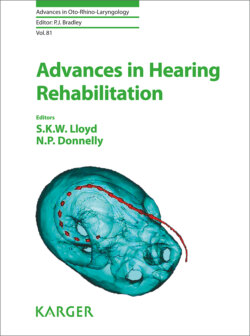Читать книгу Advances in Hearing Rehabilitation - Группа авторов - Страница 33
На сайте Литреса книга снята с продажи.
Basic Middle Ear Mechanical Concepts
ОглавлениеFundamentally, the mechanical function of the middle ear is to transmit acoustic energy from air to the cochlear fluids. The most important mechanism used to achieve this is to collect acoustic energy over a large surface area (the TM), which is relatively better matched to air (i.e., large volume velocity, low pressure), and then focus on a smaller surface area at the oval window (low volume velocity, high pressure), which then has enough force to vibrate the inner ear fluids [3, 4]. This is the pressure (NOT energy) gain of the middle ear, and based on the area ratios of the TM and oval window, is about 20:1, which is about 26 dB.
The middle ear approaches this level of gain in the lower frequencies below 2 kHz [5], when the TM and middle ear structures move in phase. At higher frequencies, the effective surface area of the TM decreases as the whole middle ear exhibits increasing out of phase movements. Fundamental to this impedance matching mechanism is that the TM can vibrate at normal audiologically relevant acoustic pressures; indeed the TM is the “engine” of the middle ear. Hence, the TM has to be relatively thin, there has to be enough middle ear air volume [6], and no perforation which creates a pressure shunt [7]. Any prosthesis that changes the TM, for example, by stiffening it, or mass loading it, will also change its function.
Normal hearing is based on achieving a pressure gain at the oval window (PGOW), and shielding the round window. Most prosthetic reconstructions try to also achieve this by connecting a vibrating TM to the oval window, either by connecting the TM directly to the remaining ossicles (PGOW I), or using a connector between the TM and the residual ossicles (PGOW II; Table 1). Another strategy is to bypass the gain of the middle ear, which on average is only about 20 dB, and expose the oval window to external canal acoustic pressure, while shielding the round window, creating a pressure differential across the basilar membrane round window protection with oval window access . The types of possible reconstructions are summarized under a scheme in Table 1.
Also important to understand is that the middle ear is almost totally dominated by stiffness in the lower frequencies, certainly below 1 kHz, and that any change in stiffness (such as increased tension on the TM or annular ligament) will have a bigger effect in the lower frequencies. Mass tends to have more effect at higher frequencies, but the middle ear does not seem to have a region in audiologically relevant frequencies where the response is purely dominated by mass.
